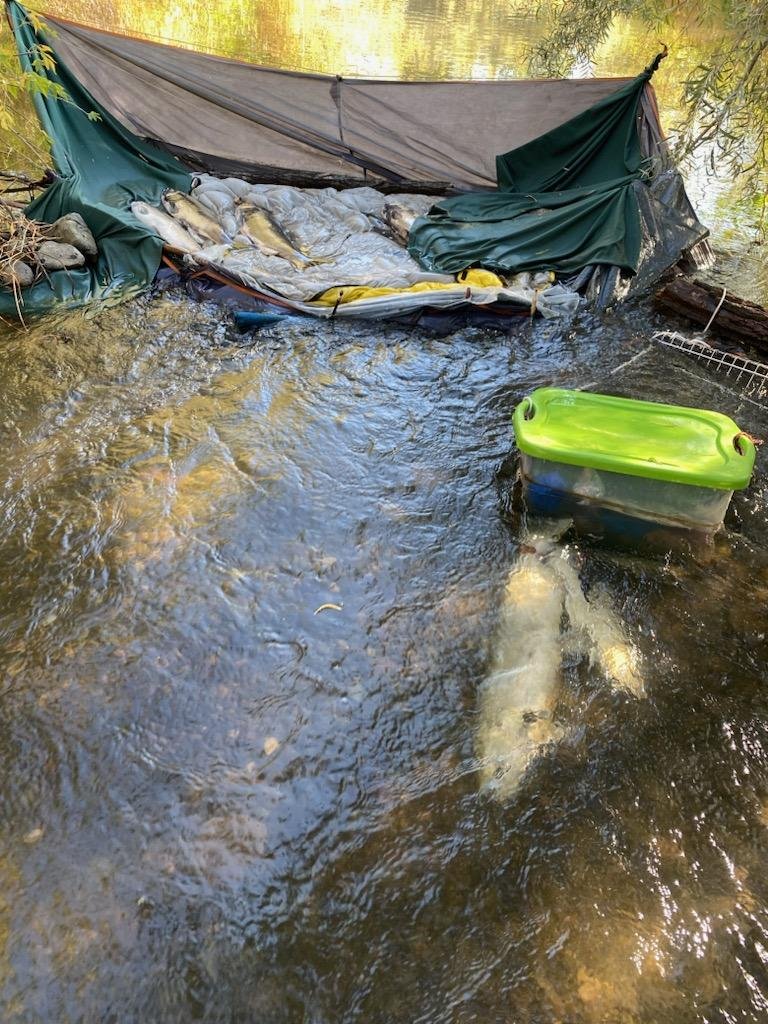Salmon Return to Bear Creek and Face Illegal Harvesting
By Frances Oyung, Rogue Riverkeeper, Program Director
Oct. 17, 2021
Fall is a great time to get outside in our region as it is time for salmon in the Pacific Northwest to return to their natal (home) watersheds to spawn, produce the next generations, and end their individual lives while the species continues. Spawning Chinook salmon (also known as king), Oncorhynchus tshawytscha, occur in many locations in the Rogue basin in October. Look for them in areas of moving water with gravel to cobble-sized substrate. Rogue tributaries like Bear Creek flowing through Ashland, Talent, Phoenix, Medford, and Central Point often have Chinook spawning through the end of October into the beginning of November.
It is important to know that Bear Creek and its tributaries are closed to fishing (except for the forks of Ashland Creek upstream of Reeder Reservoir), primarily to protect wild steelhead and coho. Recently, Chinook salmon are being illegally caught and killed in Bear Creek. If you see poor human behavior (harassing, snagging, netting, angling) that targets these salmon and other fish in Bear Creek or tributaries, do not engage the violators but please report this to the Oregon State Police dispatch at *OSP or 541-664-4600. They will want to know the exact location and details, and will probably have a fish and wildlife trooper call you back. The Oregon Department of Fish & Wildlife (ODFW) fish biologists would also appreciate reports of these types of activities.
There are six species of Pacific salmon, and two occur in the Rogue basin. In addition to Chinook salmon, coho salmon (also known as silver), Oncorhynchus kisutch are also found in the Rogue Basin. The Rogue population of coho salmon is listed as threatened under the Endangered Species Act. All of the Pacific salmon are anadromous, meaning that they are born in freshwater and then make their way to the ocean where they live for a period of time, feeding on the abundance in the ocean before returning to the freshwater streams and rivers where they were born. There, the fish spawn and die, rejoining the inland food web and returning their bodies as nutrients to the surrounding water and land. The Rogue basin including its tributaries such as Bear Creek have some of the largest salmon populations in Oregon. In addition to salmon, other anadromous fish in the Rogue include steelhead trout, Oncorhynchus mykiss, the anadromous form of rainbow trout, and Pacific lamprey, Entosphenus tridentatus. Our Bear Creek Restoration Initiative partners, the Rogue basin fish biologists at the Oregon Department of Fish & Wildlife, would like to hear if you see any salmon spawning in the Talent and Ashland area.
As of mid-October this year, some parts of Bear Creek are very shallow due to low rainfall, making fish passage to spawning areas more difficult. Hopefully, coming rains will allow easier access to the upper reaches of Bear Creek, but even with a dry fall, the lower Bear Creek area (Central Point to Medford) should have sufficient flow for Chinook spawning. In recent years, the expanded range of fall Chinook in Bear Creek all the way up to Ashland is one of the success stories for restoration in this watershed.
After Chinook start the fish spawning cycle in Bear Creek, other fish species spawn, including coho salmon, summer steelhead, cutthroat trout, winter steelhead, Klamath smallscale suckers, and Pacific lamprey spawning in the spring. As stream flows get larger and fall rains progress (hopefully!), it is harder to see these fish during spawning, but if you are in an area with suitable spawning habitat, you just might catch a view.
This October, Rogue Riverkeeper and others who love clean water are celebrating the 50th anniversary of the Clean Water Act. Rogue Riverkeeper works throughout the Rogue basin and with partners to protect and restore clean water so that native fish populations can continue to survive. To celebrate clean water this fall, get yourself out onto a local waterway and scan the riffles and gravel beds for fish. See for yourself as a salmon’s amazing journey allows the species to continue.


